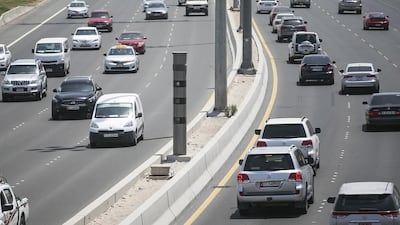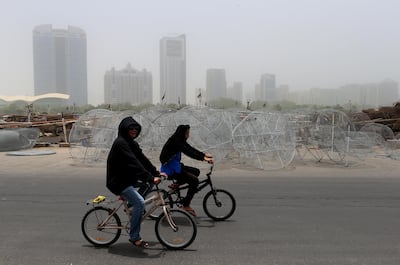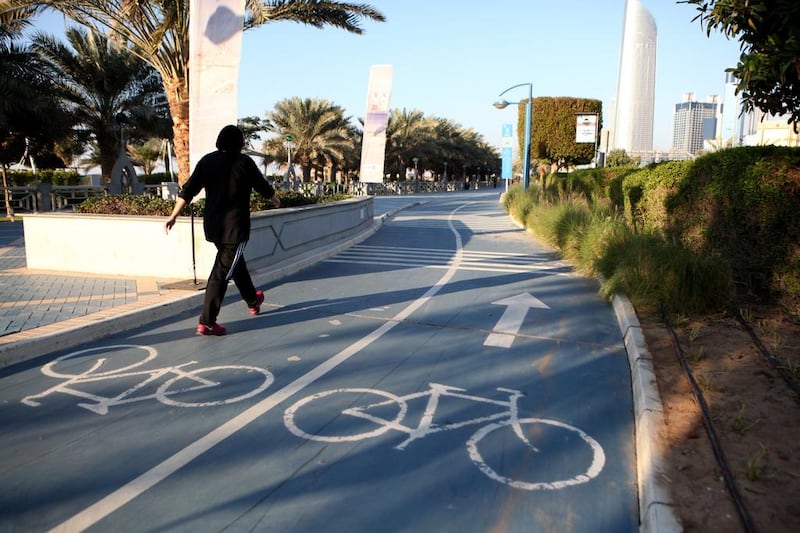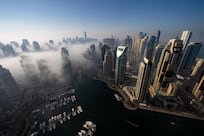Abu Dhabi has done much to improve provision for cyclists and pedestrians – but more changes could help to make the city more connected, according to a new report.
Researchers highlighted how main roads in the city, while good at connecting areas that are far apart, separate adjacent neighbourhoods.
Like many other cities in the Gulf, Abu Dhabi has developed in ways that focus on car travel, but the researchers said it could be altered to better suit public transport.
“Cars connect us to the places we have to go. However, there are cases where the design of the city … prioritises movement of cars instead of any other element of transportation in the city, including walking, cycling and public transportation,” said Dr Apostolos Kyriazis of Abu Dhabi University, one of the report’s authors.
The document, titled Roads (Dis)connecting Cities and Neighbourhoods: A Socio-Spatial Study of Abu Dhabi, is the result of a two-year collaboration between researchers at the London School of Economics and Abu Dhabi University, funded by the Emirates Foundation. This project also resulted in a major exhibition on Abu Dhabi at the LSE last year.
The road ahead
In Abu Dhabi, a city of 1.8 million people, 98 per cent of goods are carried by road. Fewer than five per cent of journeys are made by public transport, a figure seen as low but not unusual for major Gulf urban areas.
The way that the major roads connect distant neighbourhoods has supported the city’s rapid development, but at the cost of creating barriers, because those major motorways can be difficult to cross, the report said.

“The city has developed local cores of activity that remain isolated and constrained by the grid of highways – a typical scenario for a car-centric city,” the report said.
Connectivity between nearby neighbourhoods can be difficult for pedestrians as well as motorists, said another of the report’s authors, Dr Alexandra Gomes of the LSE.
She said that during her own visits, she had sometimes found it difficult to travel within Abu Dhabi island, such as when going to the Corniche.
The report also highlights that the city's suburbs are spread out from one another and have low-density housing.
Public transport is more suited to serving high-density areas because larger numbers of people live near stops and stations.
The density of suburbs could be increased, Dr Kyriazis said, by “acupuncture urbanism”, in which development takes place at particular points, which can become transportation hubs.
“One can organise the neighbourhood around [these],” he said. “Once you attract more people, you have to make sure those people, where they live, have more facilities and amenities to enjoy.”
15-minute city
This is related, he said, to the concept of the 15-minute city, in which residents can reach almost everything they need for day-to-day living, including work, schools, healthcare and shops, within 15 minutes’ travel by foot, bicycle or public transport.
If there is more public transport provision to these areas, along with shops at street level, density can be increased, perhaps by building a couple of storeys higher, Dr Kyriazis said. Public spaces can be added.
Higher-density areas of Abu Dhabi have alleyways or sikkas within neighbourhoods that are often, Dr Gomes said, “disregarded as public space or streets”.
“But they can become something that is fundamental to how people move around their own neighbourhoods,” Dr Gomes said.
Many areas around sikkas are used well by residents as outdoor spaces, with armchairs and sofas placed outside where people can relax in the evenings.
The report notes that “good connectivity” can be found in four denser areas of the city, Reem Island, Tourist Club, Shabiya and Al Reef.
“This is partially due to the permeability of the sikka system and to shorter distances between traffic lights that provide U-turns or left turns,” the report said.
Abu Dhabi’s parking provision is generous, the report notes, and the road network is typically able to cope with the number of road users, thanks in part to optimistic growth forecasts having been used when planning took place.
Get on your bike

The report also highlights how Abu Dhabi has invested significantly in pedestrian and cycling infrastructure, with more than 300km of cycle paths developed within the past decade, for example.
These newer cycle and footpaths are primarily geared towards leisure and promoting healthy lifestyles. The study says that it would be good if there was similar provision for cyclists who commute to work.
It was important, Dr Gomes said, that cycle and footpaths connected areas that people needed to travel between.
“If you are not connecting … the pedestrian and cyclist infrastructure to points of interest, people will not use it,” she said.
There has been, Dr Kyriazis said, a great deal of regeneration in downtown Abu Dhabi, including through the provision of “urban furniture” that allows people to walk then rest and get protection from the sun. He hopes to see more of this.
The city could also be made more pedestrian-friendly by increasing the number of crossing points such as bridges or underpasses for major roads in the central business district, according to Dr Gomes.
Abu Dhabi Metro
Dedicated lanes could improve public transport provision, particularly by bus, but a metro station, not unlike the one in Dubai, could be a game-changer, according to Dr Gomes.
Dubai Metro, which opened in 2009, has helped the city increase the proportion of journeys taken by public transport to 15 per cent.
Riyadh is set to open a metro this year, Bahrain is developing a system and Damman, Jeddah, Kuwait City and Muscat intend to do the same.
A metro in Abu Dhabi, with stations easily accessible by foot, is seen as likely to have a significant positive effect.
“If you use the car all the time, you’re isolated from urban life. If you use the metro, you’ll be more connected with people, more engaged with the city,” Dr Gomes said.
“It’s definitely something that Abu Dhabi needs. Not only Abu Dhabi, but most cities I know in the Middle East need good investment in proper public transport that is reliable, that is frequent.”
There are examples of urban areas in the Gulf that Abu Dhabi and other cities in the region can look to for inspiration as they continue to develop.
Dr Kyriazis highlighted Dubai Marina, with its metro and tram links, and pedestrianisation in the waterside area. The old town of Muscat and Msheireb in Doha, which has been regenerated, are other good examples.
“I really hope we take those examples and we use them in a constructive way,” he said.







